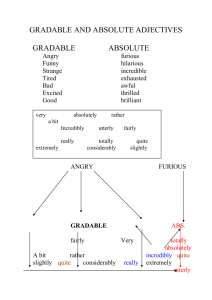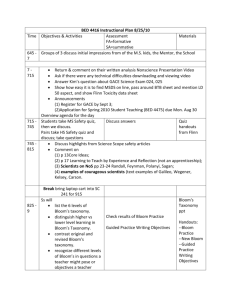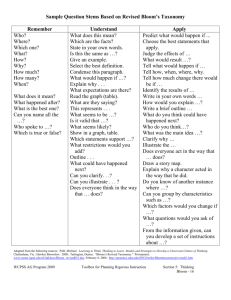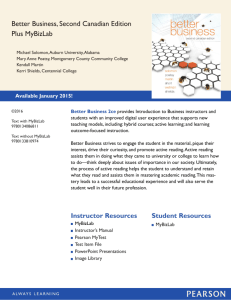Environmental Science Test Bank - Chapter 01
advertisement
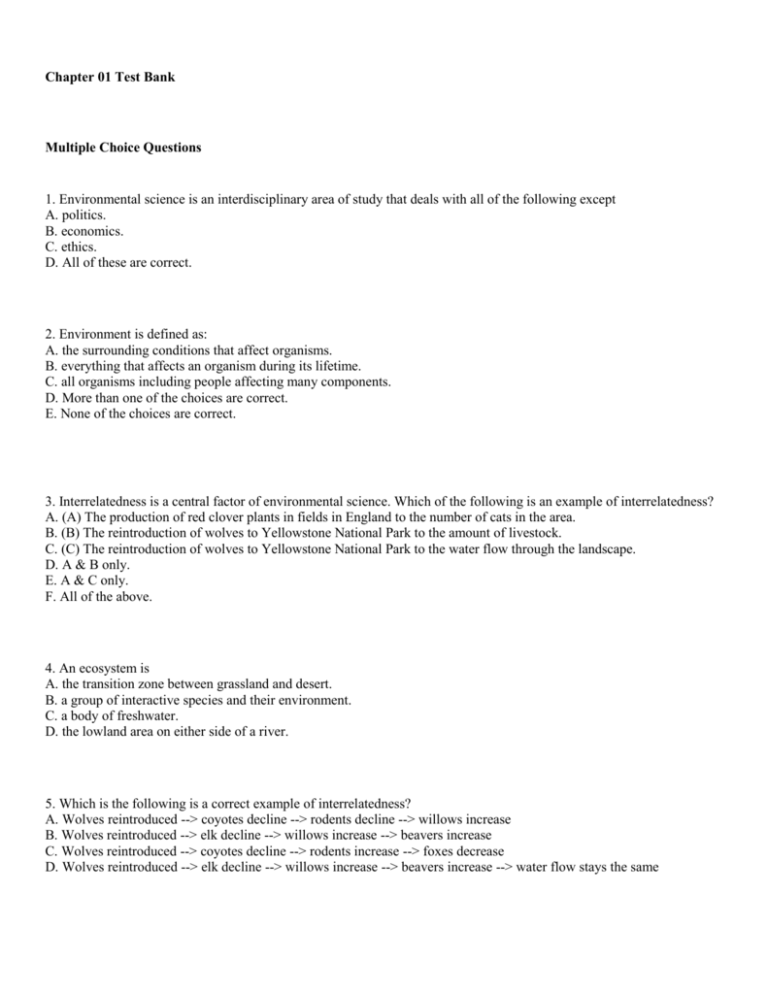
Chapter 01 Test Bank Multiple Choice Questions 1. Environmental science is an interdisciplinary area of study that deals with all of the following except A. politics. B. economics. C. ethics. D. All of these are correct. 2. Environment is defined as: A. the surrounding conditions that affect organisms. B. everything that affects an organism during its lifetime. C. all organisms including people affecting many components. D. More than one of the choices are correct. E. None of the choices are correct. 3. Interrelatedness is a central factor of environmental science. Which of the following is an example of interrelatedness? A. (A) The production of red clover plants in fields in England to the number of cats in the area. B. (B) The reintroduction of wolves to Yellowstone National Park to the amount of livestock. C. (C) The reintroduction of wolves to Yellowstone National Park to the water flow through the landscape. D. A & B only. E. A & C only. F. All of the above. 4. An ecosystem is A. the transition zone between grassland and desert. B. a group of interactive species and their environment. C. a body of freshwater. D. the lowland area on either side of a river. 5. Which is the following is a correct example of interrelatedness? A. Wolves reintroduced --> coyotes decline --> rodents decline --> willows increase B. Wolves reintroduced --> elk decline --> willows increase --> beavers increase C. Wolves reintroduced --> coyotes decline --> rodents increase --> foxes decrease D. Wolves reintroduced --> elk decline --> willows increase --> beavers increase --> water flow stays the same 6. The Earth Summit was A. the first worldwide meeting dealing with environmental concerns. B. formerly known as the UNCED. C. held in Rio de Janeiro in 1992. D. All of these are correct. 7. The result of the 1997 Kyoto Summit was an international commitment to A. reduce the amount rainforest logging. B. increase the amount of land placed in conservation easement. C. reduce emissions of greenhouses gases. D. reduce the number of oil spills. 8. Agenda 21 was an agreement by A. seven nations to halt CFC production in 1987. B. 90 nations to enhance global biodiversity in 2000. C. 178 nations for comprehensive sustainable development in 1992. D. 300 nations to limit trade in endangered species in 1985. 9. The organization of colleges and universities in the United States and Canada that promotes sustainability in higher education is called A. UNCED. B. UNESCO. C. AASHE. D. STARS. 10. Malaria is widespread in tropical and subtropical regions, with some 525 million cases occurring annually and resulting in one to three million deaths, mainly in young children: A. of the Quechua Indians in Peru. B. in Sub-Saharan Africa. C. of the Jesuits in Europe. D. of the pilgrims in Massachusetts. True / False Questions 11. Science is an approach to studying the supernatural world that involves formulating hypotheses and then testing them to see if the hypotheses are supported or refuted. True False 12. Environmental science is a narrowly defined field of physical and biological sciences. True False 13. The reintroduction of wolves to Yellowstone National Park did not have an impact on the ecosystem. True False 14. Ecosystem boundaries are usually defined by easily identifiable demarcations. True False 15. The ecosystem approach requires scientists to recognize and understand natural interactions and to integrate this with human needs for natural resources. True False 16. Biodiversity is fundamental to human welfare and economic development and plays a critical role in meeting human needs by maintaining the ecological processes upon which our survival depends. True False 17. The word environment is usually understood to mean the surrounding conditions that affect organisms, but a broader definition would include everything that affects an organism during its lifetime. True False 18. Some ecosystems have easily recognized boundaries, such as lakes, islands, or floodplains. True False 19. UNCED was the former name for the Earth Summit. True False 20. Economic considerations are not involved with environmental decisions. True False 21. Air pollution generated in China affects air quality in WESTERN coastal states in the United States and in British Columbia, Canada. True False Fill in the Blank Questions 22. According to the World Health Organization, almost ___________ of all diseases are caused by environmental exposure. ________________________________________ Check All That Apply Questions 23. The World Health Organization (WHO) estimates that 13 million deaths worldwide could be prevented every year by environmental improvement. Environmental risks include (check all the apply): ____ ____ ____ ____ ____ pollution landfill overflow noise cancer climate and ecosystem change 24. According to WHO, seven children die of diarrhea every minute globally, mainly due to (check all the apply): ____ ____ ____ ____ poor quality drinking water malnutrition uncontaminated food virus, bacteria or parasites Short Answer Questions 25. What is coronary heart disease, or CHD? Chapter 01 Test Bank Key Multiple Choice Questions 1. Environmental science is an interdisciplinary area of study that deals with all of the following except A. politics. B. economics. C. ethics. D. All of these are correct. Bloom's Level: 1. Remember Gradable: automatic Section: 01.01 Topic: Environmental Science 2. Environment is defined as: A. the surrounding conditions that affect organisms. B. everything that affects an organism during its lifetime. C. all organisms including people affecting many components. D. More than one of the choices are correct. E. None of the choices are correct. Bloom's Level: 1. Remember Gradable: automatic Section: 01.01 Topic: Environment 3. Interrelatedness is a central factor of environmental science. Which of the following is an example of interrelatedness? A. (A) The production of red clover plants in fields in England to the number of cats in the area. B. (B) The reintroduction of wolves to Yellowstone National Park to the amount of livestock. C. (C) The reintroduction of wolves to Yellowstone National Park to the water flow through the landscape. D. A & B only. E. A & C only. F. All of the above. Bloom's Level: 1. Remember Gradable: automatic Section: 01.01 Topic: Environmental Science 4. An ecosystem is A. the transition zone between grassland and desert. B. a group of interactive species and their environment. C. a body of freshwater. D. the lowland area on either side of a river. Bloom's Level: 1. Remember Gradable: automatic Section: 01.01 Topic: Ecosystems 5. Which is the following is a correct example of interrelatedness? A. Wolves reintroduced --> coyotes decline --> rodents decline --> willows increase B. Wolves reintroduced --> elk decline --> willows increase --> beavers increase C. Wolves reintroduced --> coyotes decline --> rodents increase --> foxes decrease D. Wolves reintroduced --> elk decline --> willows increase --> beavers increase --> water flow stays the same Bloom's Level: 1. Remember Gradable: automatic Section: 01.01 Topic: Environmental Science 6. The Earth Summit was A. the first worldwide meeting dealing with environmental concerns. B. formerly known as the UNCED. C. held in Rio de Janeiro in 1992. D. All of these are correct. Bloom's Level: 1. Remember Gradable: automatic Section: 01.02 Topic: Environment Topic: Globalization 7. The result of the 1997 Kyoto Summit was an international commitment to A. reduce the amount rainforest logging. B. increase the amount of land placed in conservation easement. C. reduce emissions of greenhouses gases. D. reduce the number of oil spills. Bloom's Level: 1. Remember Gradable: automatic Section: 01.02 Topic: Environment Topic: Globalization 8. Agenda 21 was an agreement by A. seven nations to halt CFC production in 1987. B. 90 nations to enhance global biodiversity in 2000. C. 178 nations for comprehensive sustainable development in 1992. D. 300 nations to limit trade in endangered species in 1985. Bloom's Level: 1. Remember Gradable: automatic Section: 01.02 Topic: Environment Topic: Globalization 9. The organization of colleges and universities in the United States and Canada that promotes sustainability in higher education is called A. UNCED. B. UNESCO. C. AASHE. D. STARS. Bloom's Level: 1. Remember Gradable: automatic Section: 01.02 Topic: Education 10. Malaria is widespread in tropical and subtropical regions, with some 525 million cases occurring annually and resulting in one to three million deaths, mainly in young children: A. of the Quechua Indians in Peru. B. in Sub-Saharan Africa. C. of the Jesuits in Europe. D. of the pilgrims in Massachusetts. Bloom's Level: 1. Remember Gradable: automatic Section: 01.02 Topic: Environment Topic: Health True / False Questions 11. Science is an approach to studying the supernatural world that involves formulating hypotheses and then testing them to see if the hypotheses are supported or refuted. FALSE Science is an approach to studying the NATURAL world, not the supernatural world. Bloom's Level: 1. Remember Gradable: automatic Section: 01.01 Topic: Science 12. Environmental science is a narrowly defined field of physical and biological sciences. FALSE Bloom's Level: 1. Remember Gradable: automatic Section: 01.01 Topic: Environmental Science 13. The reintroduction of wolves to Yellowstone National Park did not have an impact on the ecosystem. FALSE Bloom's Level: 1. Remember Gradable: automatic Section: 01.01 Topic: Environmental Science 14. Ecosystem boundaries are usually defined by easily identifiable demarcations. TRUE Bloom's Level: 1. Remember Gradable: automatic Section: 01.01 Topic: Ecosystems 15. The ecosystem approach requires scientists to recognize and understand natural interactions and to integrate this with human needs for natural resources. TRUE Bloom's Level: 1. Remember Gradable: automatic Section: 01.01 Topic: Ecosystems 16. Biodiversity is fundamental to human welfare and economic development and plays a critical role in meeting human needs by maintaining the ecological processes upon which our survival depends. TRUE Bloom's Level: 1. Remember Gradable: automatic Section: 01.02 Topic: Ecosystems 17. The word environment is usually understood to mean the surrounding conditions that affect organisms, but a broader definition would include everything that affects an organism during its lifetime. TRUE Bloom's Level: 1. Remember Gradable: automatic Section: 01.01 Topic: Environment 18. Some ecosystems have easily recognized boundaries, such as lakes, islands, or floodplains. TRUE Bloom's Level: 1. Remember Gradable: automatic Section: 01.01 Topic: Ecosystems 19. UNCED was the former name for the Earth Summit. TRUE Bloom's Level: 1. Remember Gradable: automatic Section: 01.02 Topic: Environment Topic: Globalization 20. Economic considerations are not involved with environmental decisions. FALSE Bloom's Level: 1. Remember Gradable: automatic Section: 01.01 Topic: Environment 21. Air pollution generated in China affects air quality in WESTERN coastal states in the United States and in British Columbia, Canada. TRUE Bloom's Level: 1. Remember Gradable: automatic Section: 01.01 Topic: Air Pollution Fill in the Blank Questions 22. According to the World Health Organization, almost ___________ of all diseases are caused by environmental exposure. one-quarter Bloom's Level: 1. Remember Gradable: automatic Section: 01.02 Topic: Environment Topic: Health Check All That Apply Questions 23. The World Health Organization (WHO) estimates that 13 million deaths worldwide could be prevented every year by environmental improvement. Environmental risks include (check all the apply): __X__ pollution _____ landfill overflow __X__ noise _____ cancer __X__ climate and ecosystem change Bloom's Level: 1. Remember Gradable: automatic Section: 01.02 Topic: Environment Topic: Health 24. According to WHO, seven children die of diarrhea every minute globally, mainly due to (check all the apply): __X__ poor quality drinking water __X__ malnutrition _____ uncontaminated food __X__ virus, bacteria or parasites Bloom's Level: 1. Remember Gradable: automatic Section: 01.02 Topic: Environment Topic: Health Short Answer Questions 25. What is coronary heart disease, or CHD? Bloom's Level: 1. Remember Gradable: manual Section: 01.02 Topic: Environment Topic: Health Chapter 01 Test Bank Summary Category # of Questio ns Bloom's Level: 1. Reme mber 25 Gradable: automatic 24 Gradable: manual 1 Section: 01.01 14 Section: 01.02 11 Topic: Air Pollution 1 Topic: Ecosystems 5 Topic: Education 1 Topic: Environment Topic: Environmental Sc ience Topic: Globalization 12 5 Topic: Health 5 Topic: Science 1 4
